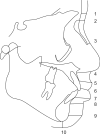Facial soft tissue thickness among skeletal malocclusions: is there a difference?
- PMID: 23112928
- PMCID: PMC3481964
- DOI: 10.4041/kjod.2012.42.1.23
Facial soft tissue thickness among skeletal malocclusions: is there a difference?
Abstract
Objective: The purpose of this study was to determine the soft tissue thickness of male and female orthodontic patients with different skeletal malocclusions.
Methods: Soft tissue thickness measurements were made on lateral cephalometric radiographs of 180 healthy orthodontic patients with different skeletal malocclusions (Class I: 60 subjects, Class II: 60 subjects, Class III: 60 subjects). Ten measurements were analyzed. For statistical evaluation, one-way ANOVA and Kruskal-Wallis tests were performed. Least significant difference (LSD) and Dunnet T3 post hoc tests were used to determine the individual differences.
Results: Soft tissue thicknesses were found to be greater for men than for women. Statistically significant differences among the skeletal groups were found in both men and women at the following sites: labrale superius, stomion, and labrale inferius. The thickness at the labrale superius and stomion points in each skeletal type was the greatest in Class III for both men and women. On the other hand, at the labrale inferius point, for both men and women, soft tissue depth was the least in Class III and the greatest in Class II.
Conclusions: Soft tissue thickness differences among skeletal malocclusions were observed at the labrale superius, stomion, and labrale inferius sites for both men and women.
Keywords: Cephalometrics; Facial profile; Skeletal malocclusions; Soft tissue thickness.
Conflict of interest statement
The authors report no commercial, proprietary, or financial interest in the products or companies described in this article.
Figures

References
-
- Arnett GW, Bergman RT. Facial keys to orthodontic diagnosis and treatment planning--Part II. Am J Orthod Dentofacial Orthop. 1993;103:395–411. - PubMed
-
- Arnett GW, Bergman RT. Facial keys to orthodontic diagnosis and treatment planning. Part I. Am J Orthod Dentofacial Orthop. 1993;103:299–312. - PubMed
-
- Miyajima K, McNamara JA, Jr, Kimura T, Murata S, Iizuka T. Craniofacial structure of Japanese and European-American adults with normal occlusions and well-balanced faces. Am J Orthod Dentofacial Orthop. 1996;110:431–438. - PubMed
-
- Hwang HS, Kim WS, McNamara JA., Jr Ethnic differences in the soft tissue profile of Korean and European-American adults with normal occlusions and well-balanced faces. Angle Orthod. 2002;72:72–80. - PubMed
-
- Bacon W, Girardin P, Turlot JC. A comparison of cephalometric norms for the African Bantu and a caucasoid population. Eur J Orthod. 1983;5:233–240. - PubMed
LinkOut - more resources
Full Text Sources
